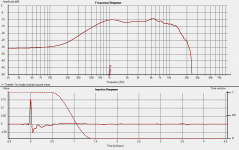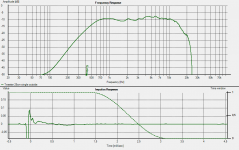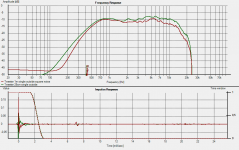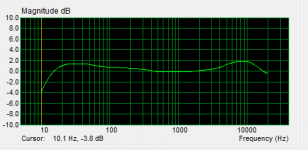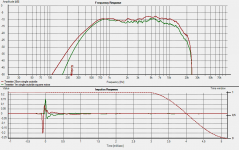Good points ICG, I tried today to see if there`s a difference in a measurement with some absorbing material around the mic and without and it seems as this material does compromise the measurement, thanks for pointing this out. Best result I got with the mic absolutely bare. But adding absorbing material on walls/floors does help, tried it too.
New set of outside measurements
Yesterday evening I have spent some serious time to do some new outside frequency measurements on the Vifa XT tweeter. Conditions are mentioned as in post # 13. Here are the results. Measuring distance 1m and 25 centimeters.
The graphs are without smoothing, if you use the smooting tool the gating marker gets lost.
Yesterday evening I have spent some serious time to do some new outside frequency measurements on the Vifa XT tweeter. Conditions are mentioned as in post # 13. Here are the results. Measuring distance 1m and 25 centimeters.
The graphs are without smoothing, if you use the smooting tool the gating marker gets lost.
Attachments
Last edited:
I only see minor differences and i find the .25m distance too unecessarily close as the impulse is relatively free from reflections, except maybe from baffle edges which are the reason for the small differences that can be seen.
Obviously the big thing here is the effect of the foam which makes totally unreliable the response above 10khz.
Btw uncalibrated mikes are not reliable above 5khz. It's ok for designing a standard xover around 2khz, but don't expect real precision for a tweeter measurement.
And trash that foam...

Obviously the big thing here is the effect of the foam which makes totally unreliable the response above 10khz.
Btw uncalibrated mikes are not reliable above 5khz. It's ok for designing a standard xover around 2khz, but don't expect real precision for a tweeter measurement.
And trash that foam...

Good points ICG, I tried today to see if there`s a difference in a measurement with some absorbing material around the mic and without and it seems as this material does compromise the measurement, thanks for pointing this out. Best result I got with the mic absolutely bare. But adding absorbing material on walls/floors does help, tried it too.
Well, why not using a gated measuring instead of absorbing material on walls/floors? If you already do, the gate is too long or you got still something reflective in too close proximity to the mic or the speaker.
I only see minor differences and i find the .25m distance too unecessarily close as the impulse is relatively free from reflections, except maybe from baffle edges which are the reason for the small differences that can be seen.
Obviously the big thing here is the effect of the foam which makes totally unreliable the response above 10khz.
Yes, the gate is unnecessarily close to the impulse. Why again 1k gate, you've already been told it's too close? The gate has to be set up to exclude the reflections by matching the surroundings, not to the impulse.
And to get comparable measurements, the gate has to stay the same. The measurement comparison seems to be reasonable close together. That is, besides the difference in level. If you equalize it, it seems it's still within ca. +/-1,5dB. Some minor differences there between the measurements but that's likely because of the different placement/angle of the mic.
I'm still not sure if there isn't something else wrong though. Look at the impulse, the green still goes negative first, that's clearly a wrong polarity. Did you change the cables of the mic or the tweeter? I would suggest to try the onboard soundcard instead for a test to clear things up. If that comes out with the same polarity, use the external soundcard and test mic and sound separately. You can also try a test with a loopback.
Btw uncalibrated mikes are not reliable above 5khz. It's ok for designing a standard xover around 2khz, but don't expect real precision for a tweeter measurement.
No, that's wrong. Uncalibrated mics may not be linear but they don't change the response! So you still get absolutely comparable measurements.
No, that's wrong. Uncalibrated mics may not be linear but they don't change the response! So you still get absolutely comparable measurements.
Wrong?
Of course you can still compare 2 measurements made with this mike, but nothing more.
And if you try to design with such uncalibrated stuff you will end tweak your xover by ear, not really because voicing matters, simply because your measurements lack precision in top octave and make you go total blind and you desperately need your ears to check how your trebble sounds...Total waste of time in listening sessions to fix pure masurements issues!
Last edited:
As you can still compare 2 measurements made with this uncalibrated mike i suggest compare the tweeter response at 1m outdoors with and without the nasty foam cap...
With Holm you can still further calculate a corrector for the foam induced low pass filter, in case you insist in protecting your mike from those outdoor wuthering winds...
I am really amazed by how you suspect about everything that might bias your measurements, except about the ... foam cap effect...
Why exactly do you so blindly trust the benefit of using that piece of foam? because it was supplied with the mike?
With Holm you can still further calculate a corrector for the foam induced low pass filter, in case you insist in protecting your mike from those outdoor wuthering winds...
I am really amazed by how you suspect about everything that might bias your measurements, except about the ... foam cap effect...
Why exactly do you so blindly trust the benefit of using that piece of foam? because it was supplied with the mike?

Last edited:
Wrong?If you don't know how unlinear your mike is you will never know how valid is your measurement...
[...]
And if you try to design with such uncalibrated stuff you will end tweak your xover by ear, not really because voicing matters, simply because your measurements lack precision in top octave and make you go total blind and you desperately need your ears to check how your trebble sounds...Total waste of time in listening sessions to fix pure masurements issues!
No, that's completely wrong. Because you've still got all the tools to get the crossover parts correct, and measuring mics actually are very linear, they mostly differ just at the ends of the measuring range. That means, all you have to do with your ears is to realize how much the upper end is off. It doesn't matter if it's +x dB, it will always the same +x dB and once it fits your ear there, keep developing it to the same level there.
So, no time waste and especally no 'total blind'.
Of course you can still compare 2 measurements made with this mike, but nothing more.
See above. But for most things it is already all you need to be able to compare what you're changing.
As you can still compare 2 measurements made with this uncalibrated mike [...]
He does not measure with an uncalibrated mic, see post #4:
The testrig is E-MU 0202 soundcard and a calibrated Samson MM01 microphone.
However, he also wrote:
The testrig is fully functional and calibrated.
That means, he does use a calibrated mic. And while I believe the mic is calibrated, I have my doubts about the complete calibrated setup though. It's not only about using the calibration file, it's what changes with the DSP, settings etc.
i suggest compare the tweeter response at 1m outdoors with and without the nasty foam cap...
Well, I already suggested that.
Why exactly do you so blindly trust the benefit of using that piece of foam? because it was supplied with the mike?
I would not trust that cap either. But it got a strong argument for it: It keeps measurements valid by keeping wind noise out (well, to a degree). Ofcourse you are absoultely right, it's not linear anymore then and I would try to avoid the cap to be on but if you always keep it on (or off), you still can measure the difference. And the main thing here isn't if it's linear, it's why it is different.
@Piersma: What amp do you use for measurements? Do you always keep the same level on the amp aswell as on the mixer and Holmimpulse? Any preamp there? Please post the whole measuring chain again.
No, that's completely wrong. Because you've still got all the tools to get the crossover parts correct, and measuring mics actually are very linear, they mostly differ just at the ends of the measuring range. That means, all you have to do with your ears is to realize how much the upper end is off. It doesn't matter if it's +x dB, it will always the same +x dB and once it fits your ear there, keep developing it to the same level there.
So, no time waste and especally no 'total blind'.
Sorry but don't understand. This is the cal file of the mike i am using. How can i guess that i have a 2db bump around 8khz? How do i know that i am wrong 2db and not 5db or 0.5db?

Attachments
@Piersma: What amp do you use for measurements? Do you always keep the same level on the amp aswell as on the mixer and Holmimpulse? Any preamp there? Please post the whole measuring chain again.
Any input or output transformer lurking in signal path, no matter if silver wound or amorphous cored?
Sorry but don't understand. This is the cal file of the mike i am using. How can i guess that i have a 2db bump around 8khz? How do i know that i am wrong 2db and not 5db or 0.5db?
At 8kHz you will still have a 2dB bigger bump (or 5dB or 0,5dB). It will not make a 2dB bump only 1dB more. The calibration makes it lniear, that means, your measurements of an uncalibrated mic are not linear but you can still measure the difference of 2 or 5dB. If you microphone can't reproduce that difference in sound pressure level, then it's not suitable as a measurement microphone. By that I don't mean the maximum spl it can measure distortion free.
With 0,5dB it's a bit different though because that's most likely within the expected repeat measurement tolerance.
Well, why not using a gated measuring instead of absorbing material on walls/floors? If you already do, the gate is too long or you got still something reflective in too close proximity to the mic or the speaker.
Because I like to push the first reflection as low as possible
@Piersma: What amp do you use for measurements? Do you always keep the same level on the amp aswell as on the mixer and Holmimpulse? Any preamp there? Please post the whole measuring chain again.[/QUOTE]
I use Current Feedback amplifier for measurements, during measurements I keep equal levels all the time. I use a passive resistive potmeter to set the SPL outputlevel.
Attached: frequency response, gating time 4 ms.
I use Current Feedback amplifier for measurements, during measurements I keep equal levels all the time. I use a passive resistive potmeter to set the SPL outputlevel.
Attached: frequency response, gating time 4 ms.
Attachments
I use Current Feedback amplifier for measurements, during measurements I keep equal levels all the time.
That's not how you measure speakers. You need a constant voltage! Where's the list of the rest? List it all!
I use a passive resistive potmeter to set the SPL outputlevel.
You mean before the amp?
Attached: frequency response, gating time 4 ms.
The polarity is still switched on one measurement. Did you do the tests of the soundcard? I'm really annoyed you only do one thing and not what's requested. I'm really tired and fed up with typing everything 5 times!
Passive preamps have high output impedance which combined with cable capacitance can produce severe HF roll off, varying morevoer with volume level setting.
Exactly! The output impedane of the pre has always to be lower than the input impedance of the amp, about 1/20th. With a passive solution you're sabotaging your measurements yourself.
Did you check the FR of your setup with a loopback measurement?
I already asked for that twice.
I'm really tired and fed up with typing everything 5 times!
Welcome to the whatamidoinwron' (fake dummy?
Last edited:
Because I like to push the first reflection as low as possible
You have to gate it to exclude it. The absorption material is frequency dependent, so it's most effective on high frequencies (where the gating could be much shorter and you don't need it) while it's much less effective at lower frequencies, where it's really needed. Try and measure how much dB it's damping. I doubt it will be much more than 2-3dB.
- Status
- This old topic is closed. If you want to reopen this topic, contact a moderator using the "Report Post" button.
- Home
- Loudspeakers
- Multi-Way
- VIFA tweeter response
